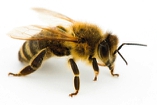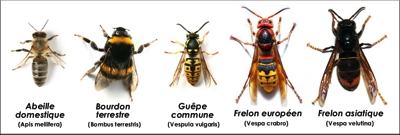Instant Online REBATE! Click here!Do not hesitate to consult with us if you notice the presence of wasps or bees on your property…

Habitat and behaviour
Wasps build their colonies in nests that can be found in cities, forests and in the countryside. Each wasps' nest can accommodate thousands of individuals. A wasp colony consists of a queen and workers. Come winter, the wasps die, except the queen who hibernates to found new colonies in spring. The fertilized queen rarely uses a nest already made by other wasps and she looks for a new site, be it near a tree, the foundations of a building or also on houses. Wasp nests can have widely varying shapes and sizes. When approaching a little too close to a wasp colony they will not hesitate to sting us in order to protect their habitat.
Reproduction
Wasps reproduce by eggs laid by the queen only. The work of the workers is to catch insects which they chew on to feed the larvae. Wasps like sweet products such as honey, wild berries and cultivated fruits such as apples, pears, etc. When they inhabit urban areas, they can feed on fruit juices, soft drinks, meat and fish.
Health risks
The wasp sting can be painful but in general, by applying ice to the bite, one obtains satisfactory relief. However, some people react strongly to the venom and one must take them immediately to an emergency clinic.
Extermination of wasps and bees
Observations on bees
At Exterminateur P.M., we recognize the essential value of bees for the planet. However, in urban areas such as Montreal, bees and wasps can nest in inappropriate places, even dangerous ones, for example in the wall of a house.
That's when treatment by a professional exterminator becomes absolutely necessary.
WASPS
Identification
The size of wasps is characterized by a significant narrowing between the thorax and the abdomen, hence the popular term "wasp waist". Like the bee, wasps live in highly organized colonies of which part are workers equipped with a stinger. The best known wasp in Quebec is black and wears stripes from yellow to white on the abdomen, thorax and head.
BEES
Identification
Bees, wasps and bumblebees are all part of the family of Hymenoptera. while some are solitary bees, the honey bee, which is best known in Quebec, is a social insect. It is distinguished by its small size, its hairy body and its legs that end in small pollen baskets. The honey bee (worker) measures ½ inch to ¾ inch (1.2 to 1.5 cm). It stings only once and then dies. It is responsible for much of the pollination of flowering plants.
Reproduction
Among the bees it is the queen that ensures the survival of the species by laying eggs. The bee is fertilized by the drone or the male bee. The multiplication of colonies of bees depends only on the spawning of the queen who can lay about 2000 eggs per day in summer and when she is healthy.
Habitat and behaviour
The bee lives inside of a wall, in a roof space or an attic and often she enters it through an opening in a brick. Subsequently, the bee builds its nest and enlarges it according to the space it finds there. It is especially in the month of July that bees are most active. If you see a hole through which the bees enter, please do not block it because these insects will invade the house.
Health risks
People react very differently to the bee sting. Some people experience pain and itching in the place where they were stung. In addition, the site of the sting is more or less swollen. Bites to the face must be taken seriously, especially the sting in the mouth. In this case, the person must be taken to the emergency ward of a hospital to prevent the risk of suffocation by a strong allergic reaction called the anaphylactic shock. Note that the strength of the reaction does not depend on the amount of venom injected.




GOT RODENTS?
GOT INSECTS?
514-817-6463
MONTREAL
WEST ISLAND
LAVAL
NORTH SHORE
SOUTH SHORE
Permit Qc # P700129
Exterminateur P.M., insects and rodent extermination specialist
Montreal, West Island, Laval, North Shore and South Shore
More than 20 years of experience! Call us now at 514-817-6463


